On the Limits of the EIS Low-Frequency Impedance Modulus as a Tool to Describe the Protection Properties of Organic Coatings Exposed to Accelerated Aging Tests
Abstract
:1. Introduction
2. Materials and Methods
2.1. Samples Preparation
2.2. Sample Aging and Characterization
3. Results
3.1. NSST Aging Results
3.2. Prohesion Test Results
4. Discussion
4.1. Comments on EIS Spectra
4.2. Correlation between |Z| and the Corrosion Development
5. Conclusions
- At least 5–6 samples are required to limit the effect of small defects and/or heterogeneities on the final results. A significant scatter in the EIS response of theoretically identical samples was observed;
- It has been shown that the |Z0.01Hz| values measured during the exposure time do not describe the actual protective properties of the organic coatings. Thanks to the transparency of the coatings, it was possible to detect the occurrence of significant and extensive corrosion processes under the paint when the EIS response |Z0.01Hz| provided values well above the thresholds generally accepted to assume an organic coating to be “protective” (e.g., 106 ohm∙cm2);
- It should be noted that we have reported on one particular experimental campaign where the collected EIS spectra could not be analyzed with a reliable EEC. In these circumstances, or whenever a less detailed analysis of the EIS spectra is proposed, the solution often used in the literature is to use the |Z0.01Hz| values for a rough description of the protective properties of the coatings under investigation. The use of |Z0.01Hz| values requires a proper analysis of the metal–polymer interface (visual inspection or adhesion test) to avoid misleading conclusions. We believe that a comparison between the actual state of degradation observed by visual inspection and the physical parameters related to the Faradic process at the metal–electrolyte interface (such as charge transfer resistance and double-layer capacitance) would likely lead to consistent results;
- In cases where it is not possible to apply nonlinear least-squares fit techniques to the raw EIS data sets, the |Z0.01Hz| values should be used with caution and coupled with additional investigation methods.
Author Contributions
Funding
Institutional Review Board Statement
Informed Consent Statement
Data Availability Statement
Acknowledgments
Conflicts of Interest
Appendix A. Paint Thickness of the Measurement Areas
| Paint Thickness Sample | Steel (µm) | HDG (µm) |
|---|---|---|
| A1 | 71.8 | 61.9 |
| A2 | 71.2 | 63.7 |
| B1 | 72.5 | 67.6 |
| B2 | 74.8 | 60.8 |
| C1 | 76 | 61.6 |
| C2 | 75.8 | 65.6 |
| Paint thickness Sample | Steel (µm) | HDG (µm) |
|---|---|---|
| A1 | 72.8 | 66.2 |
| A2 | 78.2 | 62.7 |
| B1 | 77.8 | 71.4 |
| B2 | 71.5 | 74.7 |
| C1 | 70.8 | 68.8 |
| C2 | 71.3 | 62.4 |
Appendix B. EIS Spectra at Different Aging Times during the Prohesion Test
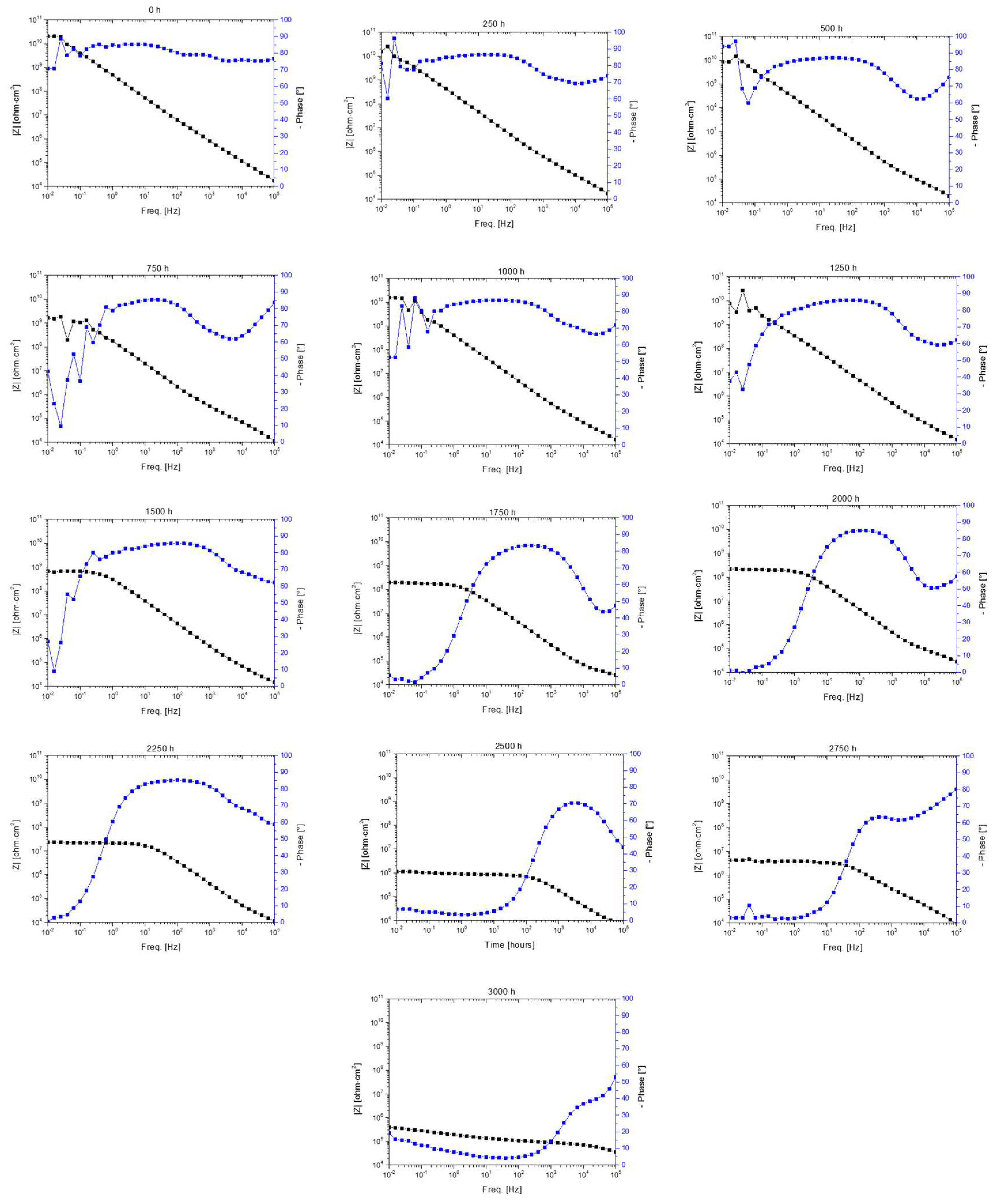
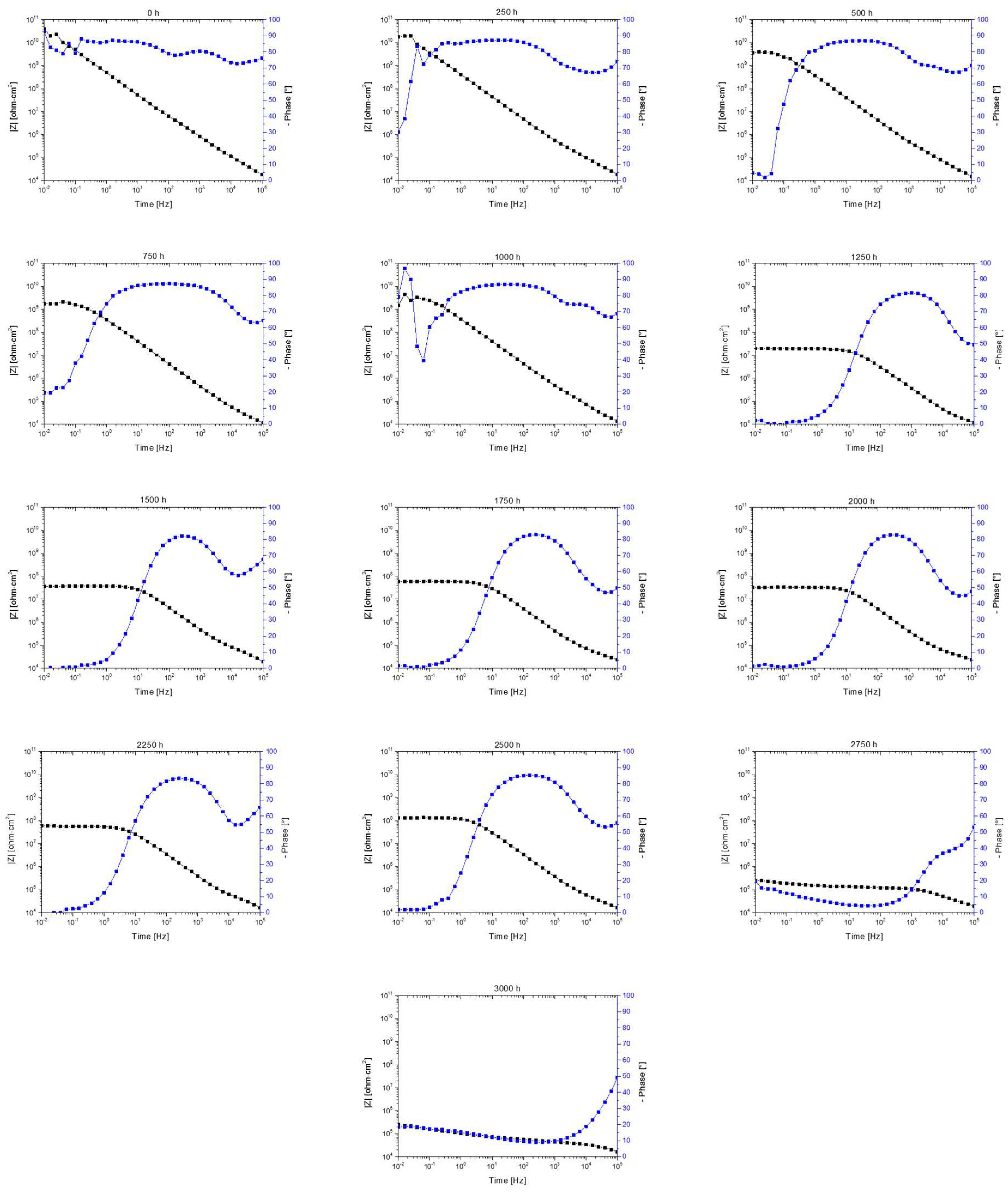
References
- Murray, J.N. Electrochemical Test Methods for Evaluating Organic Coatings on Metals: An Update. Part III: Multiple Test Parameter Measurements. Prog. Org. Coat. 1997, 31, 375–391. [Google Scholar] [CrossRef]
- Margarit-Mattos, I.C.P. EIS and Organic Coatings Performance: Revisiting Some Key Points. Electrochim. Acta 2020, 354, 136725. [Google Scholar] [CrossRef]
- Dornbusch, M.; Kirsch, S.; Henzel, C.; Deschamps, C.; Overmeyer, S.; Cox, K.; Wiedow, M.; Tromsdorf, U.; Dargatz, M.; Meisenburg, U. Characterization of the Water Uptake and Electrolyte Uptake of Organic Coatings and the Consequences by Means of Electrochemical Impedance Spectroscopy and UV–Vis Spectroscopy. Prog. Org. Coat. 2015, 89, 332–343. [Google Scholar] [CrossRef]
- Miszczyk, A.; Darowicki, K. Water Uptake in Protective Organic Coatings and Its Reflection in Measured Coating Impedance. Prog. Org. Coat. 2018, 124, 296–302. [Google Scholar] [CrossRef]
- Vosgien Lacombre, C.; Bouvet, G.; Trinh, D.; Mallarino, S.; Touzain, S. Effect of Pigment and Temperature onto Swelling and Water Uptake during Organic Coating Ageing. Prog. Org. Coat. 2018, 124, 249–255. [Google Scholar] [CrossRef]
- Deflorian, F.; Rossi, S. An EIS Study of Ion Diffusion through Organic Coatings. Electrochim. Acta 2006, 51, 1736–1744. [Google Scholar] [CrossRef]
- Duarte, R.G.; Castela, A.S.; Ferreira, M.G.S. A New Model for Estimation of Water Uptake of an Organic Coating by EIS: The Tortuosity Pore Model. Prog. Org. Coat. 2009, 65, 197–205. [Google Scholar] [CrossRef]
- Castela, A.S.L.; Simões, A.M.; Ferreira, M.G.S.E.I.S. Evaluation of Attached and Free Polymer Films. Prog. Org. Coat. 2000, 38, 1–7. [Google Scholar] [CrossRef]
- Mahdavi, F.; Forsyth, M.; Tan, M.Y.J. Techniques for Testing and Monitoring the Cathodic Disbondment of Organic Coatings: An Overview of Major Obstacles and Innovations. Prog. Org. Coat. 2017, 105, 163–175. [Google Scholar] [CrossRef]
- Deflorian, F.; Fedrizzi, L.; Rossi, S. Effects of Mechanical Deformation on the Protection Properties of Coil Coating Products. Corros. Sci. 2000, 42, 1283–1301. [Google Scholar] [CrossRef]
- Fredj, N.; Cohendoz, S.; Feaugas, X.; Touzain, S. Effect of Mechanical Stresses on Marine Organic Coating Ageing Approached by EIS Measurements. Prog. Org. Coat. 2011, 72, 260–268. [Google Scholar] [CrossRef]
- Alizadeh Razin, A.; Ramezanzadeh, B.; Yari, H. Detecting and Estimating the Extent of Automotive Coating Delamination and Damage Indexes after Stone Chipping Using Electrochemical Impedance Spectroscopy. Prog. Org. Coat. 2016, 92, 95–109. [Google Scholar] [CrossRef]
- Bierwagen, G.P.; Tallman, D.E. Choice and Measurement of Crucial Aircraft Coatings System Properties. Prog. Org. Coat. 2001, 41, 201–216. [Google Scholar] [CrossRef]
- Buchheit, R.G.; Cunningham, M.; Jensen, H.; Kendig, M.W.; Martinez, M.A. A Correlation between Salt Spray and Electrochemical Impedance Spectroscopy Test Results for Conversion-Coated Aluminum Alloys. Corrosion 1998, 54, 61–69. [Google Scholar] [CrossRef]
- Cambier, S.M.; Posner, R.; Frankel, G.S. Coating and Interface Degradation of Coated Steel, Part 1: Field Exposure. Electrochim. Acta 2014, 133, 30–39. [Google Scholar] [CrossRef]
- Mills, D.J.; Jamali, S.S. The Best Tests for Anti-Corrosive Paints. And Why: A Personal Viewpoint. Prog. Org. Coat. 2017, 102, 8–17. [Google Scholar] [CrossRef] [Green Version]
- ASTM B117-19; Standard Practice for Operating Salt Spray (Fog) Apparatus. ASTM International: West Conshohocken, PA, USA, 2019.
- ASTM G85-19; Standard Practice for Modified Salt Spray (Fog) Testing, ASTM International: West Conshohocken, PA, USA, 2019.
- ASTM B368-21; Standard Test Method for Copper-Accelerated Acetic Acid-Salt Spray (Fog) Testing (CASS Test). ASTM International: West Conshohocken, PA, USA, 2021.
- ASTM D1735-14; Standard Practice for Testing Water Resistance of Coatings Using Water Fog Apparatus. ASTM International: West Conshohocken, PA, USA, 2014.
- ASTM D2247-15(2020); Standard Practice for Testing Water Resistance of Coatings in 100% Relative Humidity. ASTM International: West Conshohocken, PA, USA, 2020.
- Singleton, R. Accelerated Corrosion Testing. Met. Finish. 2012, 110, 12–19. [Google Scholar] [CrossRef]
- Kiosidou, E.D.; Karantonis, A.; Sakalis, G.N.; Pantelis, D.I. Electrochemical Impedance Spectroscopy of Scribed Coated Steel after Salt Spray Testing. Corros. Sci. 2018, 137, 127–150. [Google Scholar] [CrossRef]
- Vosgien Lacombre, C.; Bouvet, G.; Trinh, D.; Mallarino, S.; Touzain, S. Water Uptake in Free Films and Coatings Using the Brasher and Kingsbury Equation: A Possible Explanation of the Different Values Obtained by Electrochemical Impedance Spectroscopy and Gravimetry. Electrochim. Acta 2017, 231, 162–170. [Google Scholar] [CrossRef]
- Jorcin, J.B.; Aragon, E.; Merlatti, C.; Pébère, N. Delaminated Areas beneath Organic Coating: A Local Electrochemical Impedance Approach. Corros. Sci. 2006, 48, 1779–1790. [Google Scholar] [CrossRef]
- Burduhos-Nergis, D.P.; Vasilescu, G.D.; Burduhos-Nergis, D.D.; Cimpoesu, R.; Bejinariu, C. Phosphate Coatings: EIS and SEM Applied to Evaluate the Corrosion Behavior of Steel in Fire Extinguishing Solution. Appl. Sci. 2021, 11, 7802. [Google Scholar] [CrossRef]
- Lu, F.; Song, B.; He, P.; Wang, Z.; Wang, J. Electrochemical Impedance Spectroscopy (EIS) Study on the Degradation of Acrylic Polyurethane Coatings. RSC Adv. 2017, 7, 13742. [Google Scholar] [CrossRef] [Green Version]
- Mahdavi, F.; Tan, M.Y.J.; Forsyth, M. Electrochemical Impedance Spectroscopy as a Tool to Measure Cathodic Disbondment on Coated Steel Surfaces: Capabilities and Limitations. Prog. Org. Coat. 2015, 88, 23–31. [Google Scholar] [CrossRef]
- Sharer Sahir, Z.; Sykes, J.M. Effect of Temperature on the Impedance Response of Coated Metals. Prog. Org. Coat. 2014, 77, 2039–2044. [Google Scholar] [CrossRef]
- Touzain, S.; Thu, Q.L.; Bonnet, G. Evaluation of Thick Organic Coatings Degradation in Seawater Using Cathodic Protection and Thermally Accelerated Tests. Prog. Org. Coat. 2005, 52, 311–319. [Google Scholar] [CrossRef]
- Fedrizzi, L.; Bergo, A.; Deflorian, F.; Valentinelli, L. Assessment of Protective Properties of Organic Coatings by Thermal Cycling. Prog. Org. Coat. 2003, 48, 271–280. [Google Scholar] [CrossRef]
- Upadhyay, V.; Battocchi, D. Exploring the Combined Effect of DC Polarization and High Temperature Exposure on the Barrier Properties of Organic Coatings. Prog. Org. Coat. 2017, 110, 42–46. [Google Scholar] [CrossRef]
- Touzain, S. Some Comments on the Use of the EIS Phase Angle to Evaluate Organic Coating Degradation. Electrochim. Acta 2010, 55, 6190–6194. [Google Scholar] [CrossRef]
- Jaśniok, T.; Jaśniok, M.; Skórkowski, A. Diagnostics of Large Non-Conductive Anti-Corrosion Coatings on Steel Structures by Means of Electrochemical Impedance Spectroscopy. Materials 2021, 14, 3959. [Google Scholar] [CrossRef] [PubMed]
- Murray, J.N.; Hack, H.P. In Proceedings of the 12th International Corrosion Congress, Houston, TX, USA, 19–24 September 1993; p. 151.
- Amirudin, A.; Thierry, D. Application of Electrochemical Impedance Spectroscopy to Study the Degradation of Polymer-Coated Metals. Prog. Org. Coat. 1995, 26, 1–28. [Google Scholar] [CrossRef]
- Fedrizzi, L.; Bergo, A.; Fanicchia, M. Evaluation of Accelerated Aging Procedures of Painted Galvanised Steels by EIS. Electrochim. Acta 2006, 51, 1864–1872. [Google Scholar] [CrossRef]
- Allahar, K.N.; Upadhyay, V.; Bierwagen, G.P.; Gelling, V.J. Monitoring of a Military Vehicle Coating under Prohesion Exposure by Embedded Sensors. Prog. Org. Coat. 2009, 65, 142–151. [Google Scholar] [CrossRef]
- Hinderliter, B.R.; Croll, S.G.; Tallman, D.E.; Su, Q.; Bierwagen, G.P. Interpretation of EIS Data from Accelerated Exposure of Coated Metals Based on Modeling of Coating Physical Properties. Electrochim. Acta 2006, 51, 4505–4515. [Google Scholar] [CrossRef]
- Nguyen, A.S.; Causse, N.; Musiani, M.; Orazem, M.E.; Pébère, N.; Tribollet, B.; Vivier, V. Determination of Water Uptake in Organic Coatings Deposited on 2024 Aluminium Alloy: Comparison between Impedance Measurements and Gravimetry. Prog. Org. Coat. 2017, 112, 93–100. [Google Scholar] [CrossRef] [Green Version]
- Rossi, S.; Deflorian, F.; Fontanari, L.; Cambruzzi, A.; Bonora, P.L. Electrochemical Measurements to Evaluate the Damage Due to Abrasion on Organic Protective System. Prog. Org. Coat. 2005, 52, 288–297. [Google Scholar] [CrossRef]
- Rammelt, U.; Reinhard, G. Application of Electrochemical Impedance Spectroscopy (EIS) for Characterizing the Corrosion-Protective Performance of Organic Coatings on Metals. Prog. Org. Coat. 1992, 21, 205–226. [Google Scholar] [CrossRef]
- Tait, W.S. Using Electrochemical Measurements to Estimate Coating and Polymer Film DurabiIity. J. Coat. Technol. 2003, 75, 45–50. [Google Scholar] [CrossRef]
- Kunce, I.; Królikowska, A.; Komorowski, L. Accelerated Corrosion Tests in Quality Labels for Powder Coatings on Galvanized Steel—Comparison of Requirements and Experimental Evaluation. Materials 2021, 14, 6547. [Google Scholar] [CrossRef]
- Yang, X.F.; Li, J.; Croll, S.G.; Tallman, D.E.; Bierwagen, G.P. Degradation of Low Gloss Polyurethane Aircraft Coatings under UV and Prohesion Alternating Exposures. Polym. Degrad. Stab. 2003, 80, 51–58. [Google Scholar] [CrossRef]
- Yu, M.; Fan, C.; Ge, F.; Lu, Q.; Wang, X.; Cui, Z. Anticorrosion Behavior of Organic Offshore Coating Systems in UV, Salt Spray and Low Temperature Alternation Simulated Arctic Offshore Environment. Mater. Today Commun. 2021, 28, 102545. [Google Scholar] [CrossRef]
- Yang, M.S.; Huang, J.; Chen, J.; Noël, J.J.; Barker, I.; Henderson, J.D.; He, P.; Zhang, H.; Zhang, H.; Zhu, J. A Comparative Study on the Anti-Corrosive Performance of Zinc Phosphate in Powder Coatings. Coatings 2022, 12, 217. [Google Scholar] [CrossRef]
- UNI 10346:2015; Continuously Hot-Dip Coated Steel Flat Products for Cold Forming—Technical Delivery Conditions. Ente Italiano di Normazione:: Milano, Italy, 2015.
- ASTM D4541-17; Standard Test Method for Pull-Off Strength of Coatings Using Portable Adhesion Testers. ASTM International: West Conshohocken, PA, USA, 2017.
- ASTM D1193-06(2018); Standard Specification for Reagent Water. ASTM International: West Conshohocken, PA, USA, 2018.
- Bouvet, G.; Nguyen, D.D.; Mallarino, S.; Touzain, S. Analysis of the Non-Ideal Capacitive Behaviour for High Impedance Organic Coatings. Prog. Org. Coat. 2014, 77, 2045–2053. [Google Scholar] [CrossRef]
- Martinez, S.; Šoić, I.; Špada, V. Unified Equivalent Circuit of Dielectric Permittivity and Porous Coating Formalisms for EIS Probing of Thick Industrial Grade Coatings. Prog. Org. Coat. 2021, 153, 106155. [Google Scholar] [CrossRef]
- Strunz, W.; Schiller, C.A.; Vogelsang, J. The Change of Dielectric Properties of Barrier Coatings during the Initial State of Immersion. Mater. Corros. 2008, 59, 159–166. [Google Scholar] [CrossRef]
- Mansfeld, F.; Xiao, H.; Han, L.T.; Lee, C.C. Electrochemical Impedance and Noise Data for Polymer Coated Steel Exposed at Remote Marine Test Sites. Prog. Org. Coat. 1997, 30, 89–100. [Google Scholar] [CrossRef]
- Trentin, A.; Pakseresht, A.; Duran, A.; Castro, Y.; Galusek, D. Electrochemical Characterization of Polymeric Coatings for Corrosion Protection: A Review of Advances and Perspectives. Polymers 2022, 14, 2306. [Google Scholar] [CrossRef]
- Ammar, S.; Ramesh, K.; Ma, I.A.W.; Farah, Z.; Vengadaesvaran, B.; Ramesh, S.; Arof, A.K. Studies on SiO2-Hybrid Polymeric Nanocomposite Coatings with Superior Corrosion Protection and Hydrophobicity. Surf. Coat. Technol. 2017, 324, 536–545. [Google Scholar] [CrossRef]
- Vlasak, R.; Klueppel, I.; Grundmeier, G. Combined EIS and FTIR–ATR study of water uptake and diffusion in polymer films on semiconducting electrodes. Electrochim. Acta 2007, 52, 8075–8080. [Google Scholar] [CrossRef]
- Tan, B.; Fu, A.; Guo, L.; Ran, Y.; Xiong, J.; Marzouki, R.; Li, W. Insight into Anti-Corrosion Mechanism of Dalbergia Odorifera Leaves Extract as a Biodegradable Inhibitor for X70 Steel in Sulfuric Acid Medium. Ind. Crops Prod. 2023, 194, 116106. [Google Scholar] [CrossRef]
- Schuurkes, J.A.A.R.; Elbers, M.A.; Gudden, J.J.F.; Roelofs, J.G.M. Effects of simulated ammonium sulphate and sulphuric acid rain on acidification, water quality and flora of small-scale soft water systems. Aquat. Bot. 1987, 28, 199–226. [Google Scholar] [CrossRef]
- Floyd, F.L.; Avudaiappan, S.; Gibson, J.; Mehta, B.; Smith, P.; Provder, T.; Escarsega, J. Using Electrochemical Impedance Spectroscopy to Predict the Corrosion Resistance of Unexposed Coated Metal Panels. Prog. Org. Coat. 2009, 66, 8–34. [Google Scholar] [CrossRef]
- Murray, J.N.; Ruedisueli, R.L. Testing Issues for Coatings for In-Service Marine Immersion Applications. In Proceedings of the CORROSION 2005, Houston, TX, USA, 3–7 April 2005. [Google Scholar]
- Tait, W.S.; Handrich, K.A.; Tait, S.W.; Martin, J.W. Analyzing and Interpreting Electrochemical Impedance Spectroscopy Data from Internally Coated Steel Aerosol Containers; Standard Technical Publication; ASTM: Philadelphia, PA, USA, 1993. [Google Scholar]
- Mansfeld, F. Models for the Impedance Behavior of Protective Coatings and Cases of Localized Corrosion. Electrochim. Acta 1993, 38, 1891–1897. [Google Scholar] [CrossRef]
- Martin, J.W.; Saunders, S.C.; Floyd, F.L.; Wineburg, J.P. Methodologies for Predicting the Service Lives of Coatings Systems; FSCT Series on Coatings Technology (Booklet); DIANE Publishing: Blue Bell, PA, USA, 1996; p. 34. [Google Scholar]
- Amand, S.; Musiani, M.; Orazem, M.E.; Pébère, N.; Tribollet, B.; Vivier, V. Constant-Phase-Element Behavior Caused by Inhomogeneous Water Uptake in Anti-Corrosion Coatings. Electrochim. Acta 2013, 87, 693–700. [Google Scholar] [CrossRef] [Green Version]
- Alsamuraee, A.; Jaafer, H. Electrochemical Impedance Spectroscopic Evaluation of Corrosion Protection Properties of Polyurethane /Polyvinyl Chloride Blend Coatings on Steel. Am. J. Sci. Ind. Res. 2011, 2, 761–768. [Google Scholar] [CrossRef]
- Hu, J.; Li, X.; Gao, J.; Zhao, Q. Ageing Behavior of Acrylic Polyurethane Varnish Coating in Artificial Weathering Environments. Prog. Org. Coat. 2009, 65, 504–509. [Google Scholar] [CrossRef]
- Bierwagen, G.; Li, J.; He, L.; Tallman, D. Fundamentals of the Measurement of Corrosion Protection and the Prediction of Its Lifetime in Organic Coatings. ACS Symp. Ser. 2002, 805, 316–350. [Google Scholar] [CrossRef]
- Kuwano, E.; Fujitani, T.; Satoh, T. A new approach to the anti-corrosion function of coatings. In Proceedings of the International Symposium on Advances in Corrosion Protection by Organic Coatings 1997, Noda, Japan, 29–31 October 1997. [Google Scholar]
- Murray, J.N. Electrochemical Test Methods for Evaluating Organic Coatings on Metals: An update. Part II: Mul-tiple test parameter measurements. Prog. Org. Coat. 1997, 31, 255–264. [Google Scholar] [CrossRef]
- Lasia, A. Electrochemical Impedance Spectroscopy and its Applications, 1st ed.; Springer: New York, NY, USA, 2017; pp. 257–261. [Google Scholar]
- Bacon, R.C.; Smith, J.J.; Rugg, F.M. Electrolytic resistance in evaluating protective merit of coatings on metals. Ind. Eng. Chem. 1948, 40, 161. [Google Scholar] [CrossRef]
- Wirth, J.K. The testing of iron corrosion under protecting films. Chem. Fabrik 1938, 11, 455. [Google Scholar]
- Cattarin, S.; Comisso, N.; Musiani, M.; Tribollet, B. The Impedance of an Electrode Coated by a Resistive Film with a Graded Thickness. Electrochem. Solid-State Lett. 2008, 11, 27–30. [Google Scholar] [CrossRef]
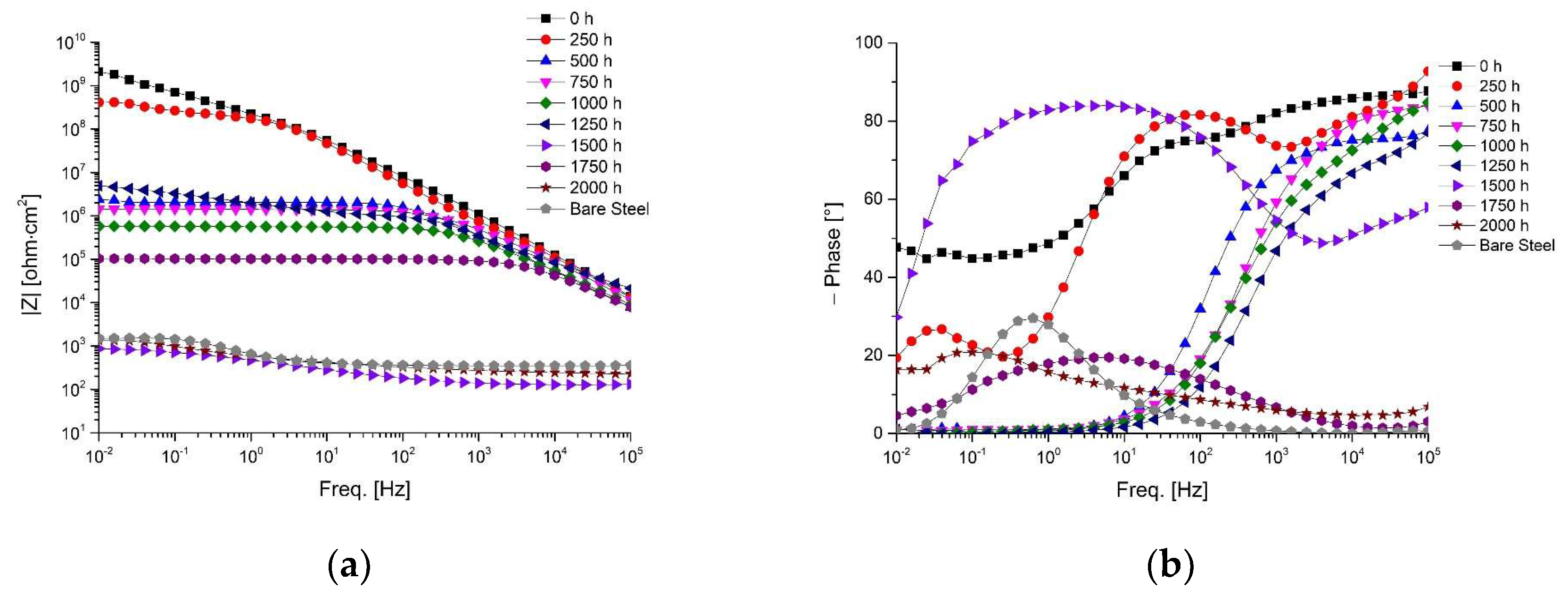

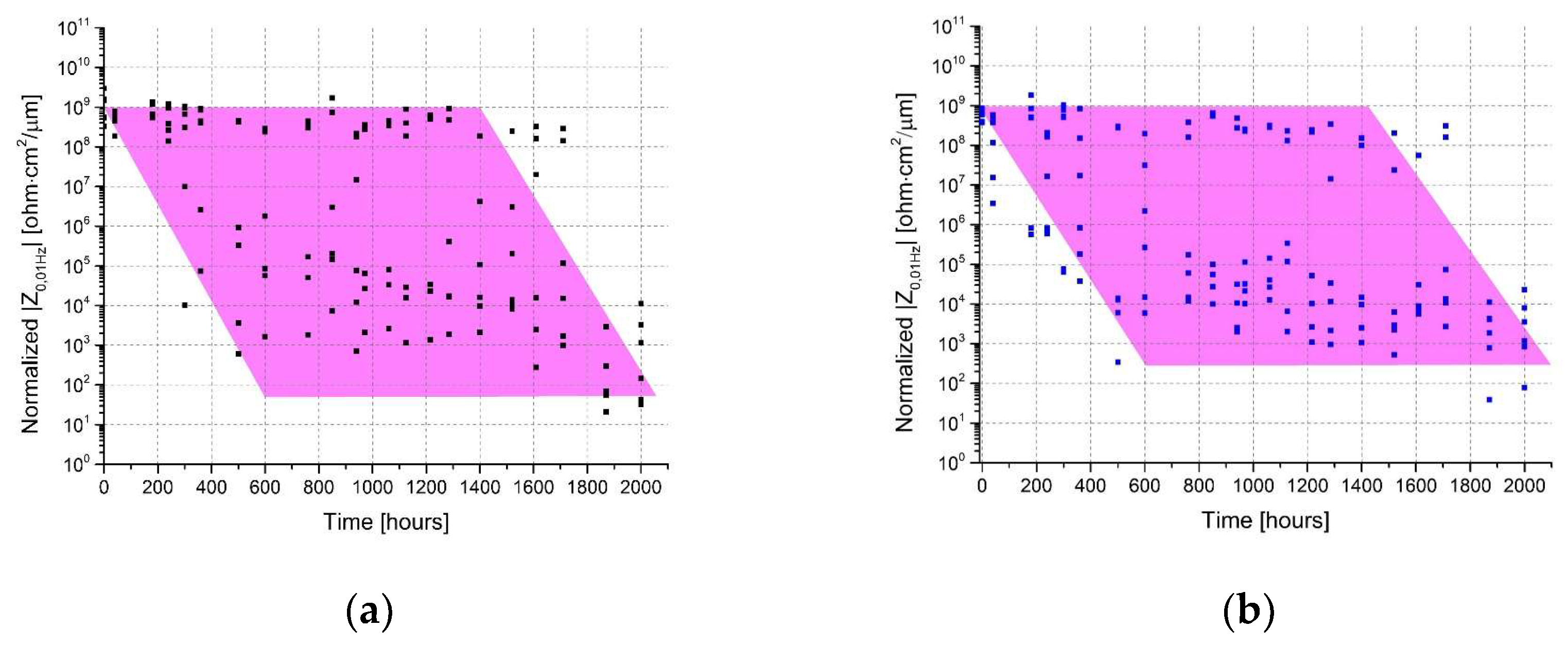
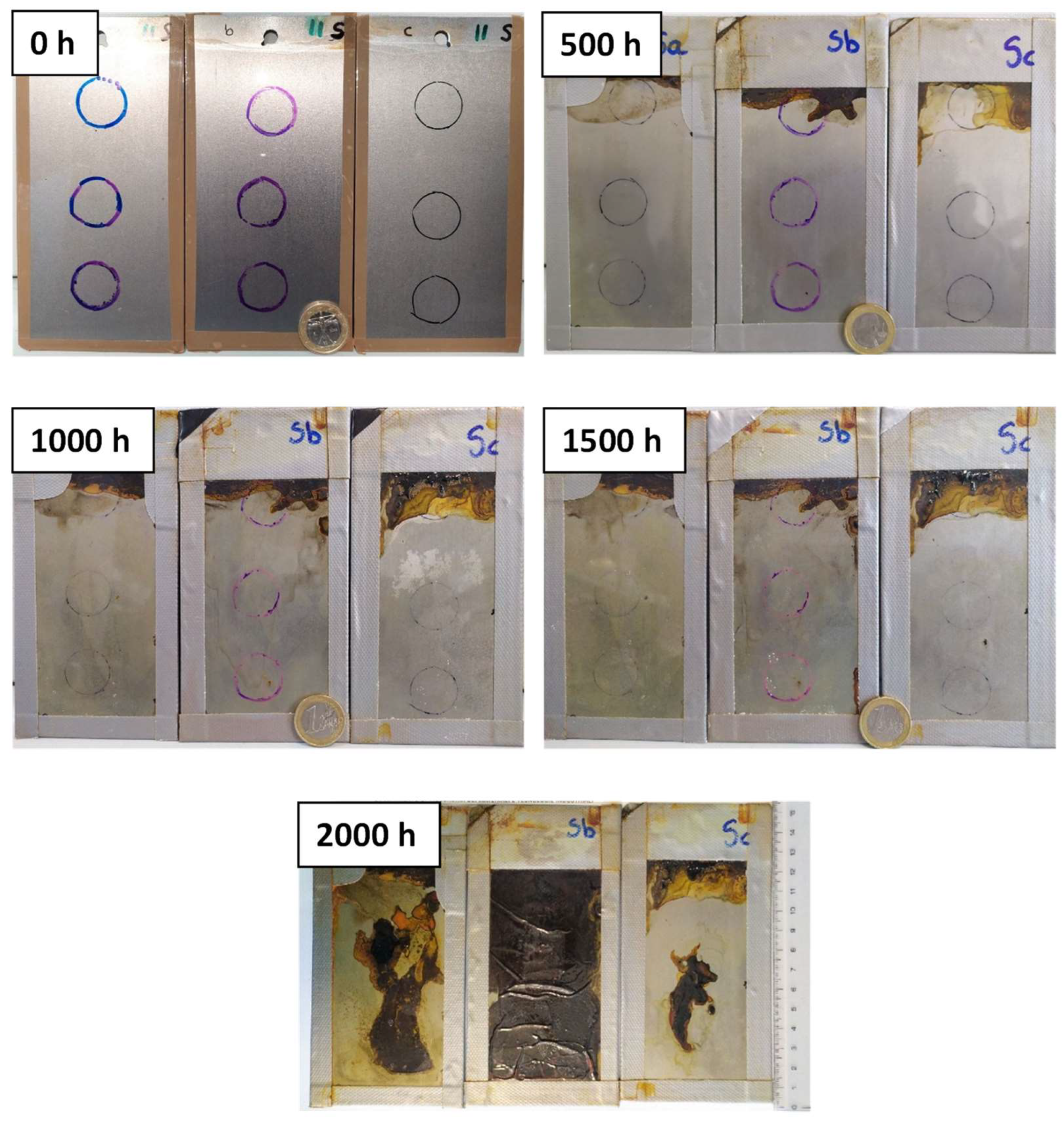

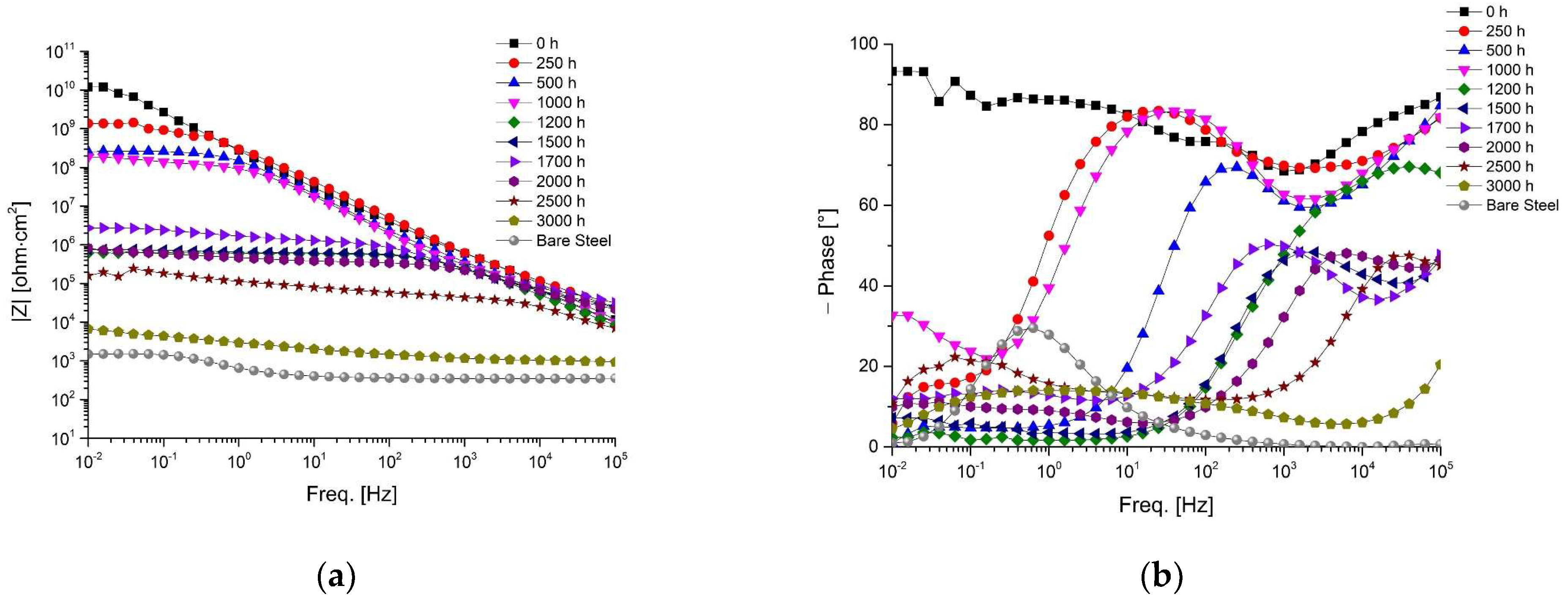

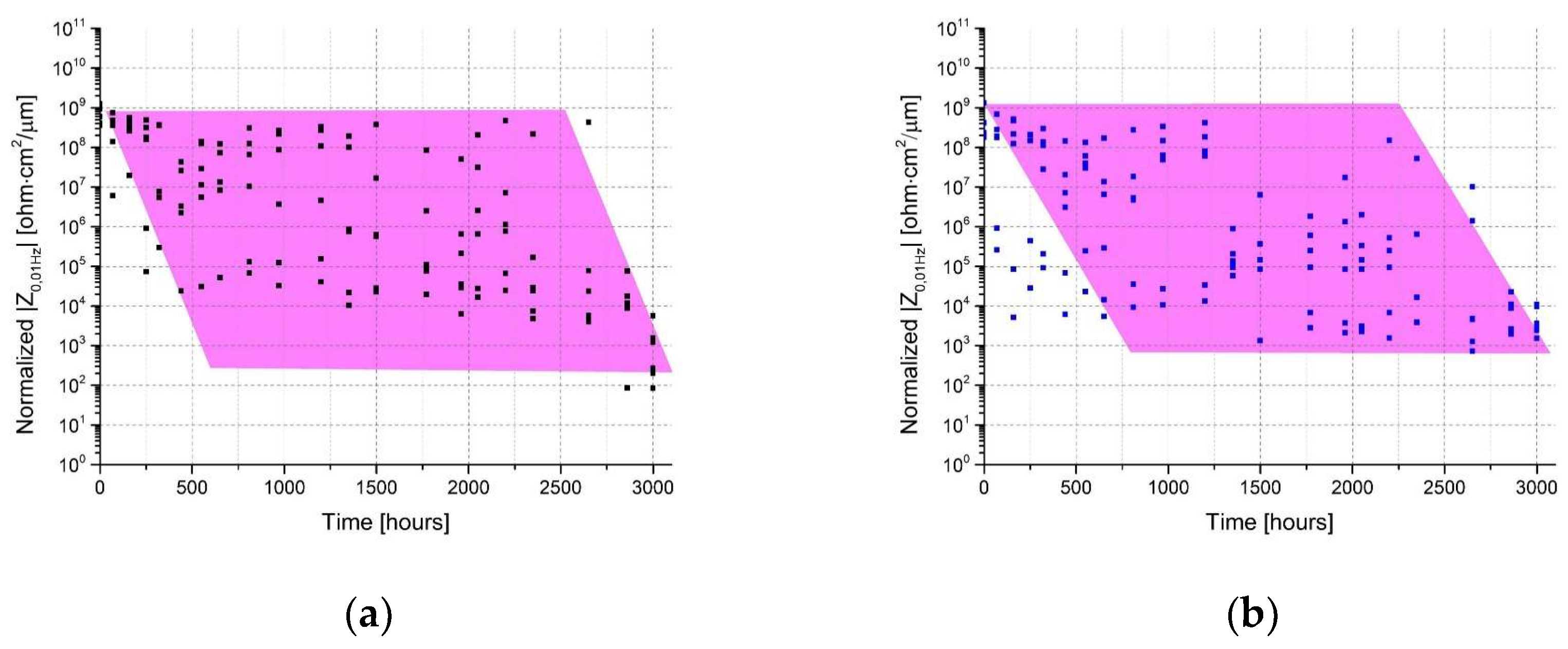
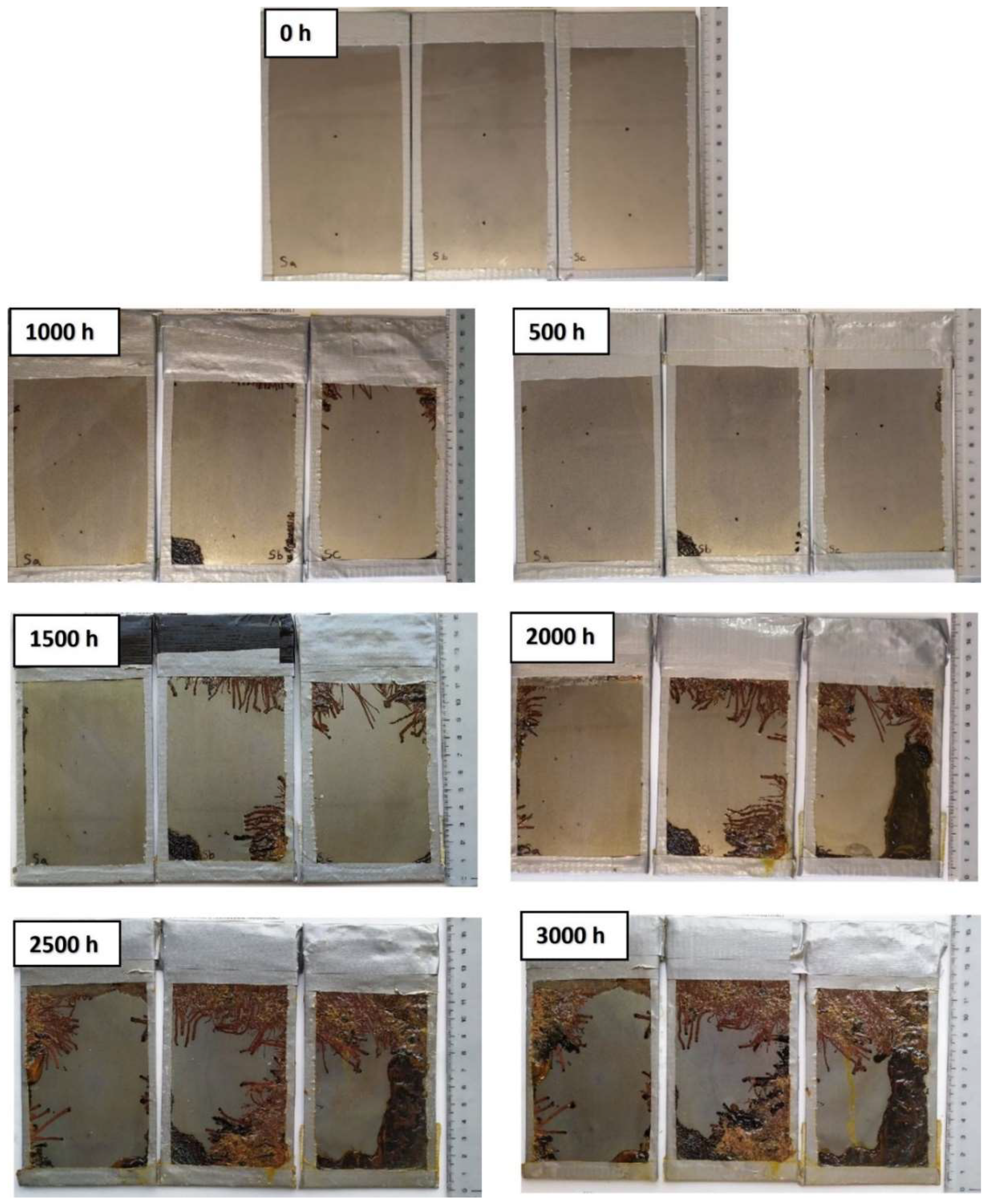




Disclaimer/Publisher’s Note: The statements, opinions and data contained in all publications are solely those of the individual author(s) and contributor(s) and not of MDPI and/or the editor(s). MDPI and/or the editor(s) disclaim responsibility for any injury to people or property resulting from any ideas, methods, instructions or products referred to in the content. |
© 2023 by the authors. Licensee MDPI, Basel, Switzerland. This article is an open access article distributed under the terms and conditions of the Creative Commons Attribution (CC BY) license (https://creativecommons.org/licenses/by/4.0/).
Share and Cite
Cristoforetti, A.; Rossi, S.; Deflorian, F.; Fedel, M. On the Limits of the EIS Low-Frequency Impedance Modulus as a Tool to Describe the Protection Properties of Organic Coatings Exposed to Accelerated Aging Tests. Coatings 2023, 13, 598. https://doi.org/10.3390/coatings13030598
Cristoforetti A, Rossi S, Deflorian F, Fedel M. On the Limits of the EIS Low-Frequency Impedance Modulus as a Tool to Describe the Protection Properties of Organic Coatings Exposed to Accelerated Aging Tests. Coatings. 2023; 13(3):598. https://doi.org/10.3390/coatings13030598
Chicago/Turabian StyleCristoforetti, Andrea, Stefano Rossi, Flavio Deflorian, and Michele Fedel. 2023. "On the Limits of the EIS Low-Frequency Impedance Modulus as a Tool to Describe the Protection Properties of Organic Coatings Exposed to Accelerated Aging Tests" Coatings 13, no. 3: 598. https://doi.org/10.3390/coatings13030598
APA StyleCristoforetti, A., Rossi, S., Deflorian, F., & Fedel, M. (2023). On the Limits of the EIS Low-Frequency Impedance Modulus as a Tool to Describe the Protection Properties of Organic Coatings Exposed to Accelerated Aging Tests. Coatings, 13(3), 598. https://doi.org/10.3390/coatings13030598








